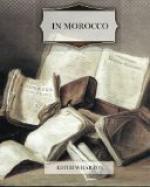Historians frankly say they do not know. All sorts of material obstacles have hitherto hampered the study of Berber origins, but it seems clear that from the earliest historic times they were a mixed race, and the ethnologist who attempts to define them is faced by the same problem as the historian of modern America who should try to find the racial definition of an “American.” For centuries, for ages, North Africa has been what America now is: the clearing-house of the world. When at length it occurred to the explorer that the natives of North Africa were not all Arabs or Moors, he was bewildered by the many vistas of all they were or might be: so many and tangled were the threads leading up to them, so interwoven was their pre-Islamite culture with worn-out shreds of older and richer societies.
M. Saladin, in his “Manuel d’Architecture Musulmane,” after attempting to unravel the influences which went to the making of the mosque of Kairouan, the walls of Marrakech, the Medersas of Fez—influences that lead him back to Chaldaean branch-huts, to the walls of Babylon and the embroideries of Coptic Egypt—somewhat despairingly sums up the result: “The principal elements contributed to Moslem art by the styles preceding it may be thus enumerated: from India, floral ornament; from Persia, the structural principles of the Acheminedes, and the Sassanian vault. Mesopotamia contributes a system of vaulting, incised ornament, and proportion; the Copts, ornamental detail in general; Egypt, mass and unbroken wall-spaces; Spain, construction and Romano-Iberian ornament; Africa, decorative detail and Romano-Berber traditions (with Byzantine influences in Persia); Asia Minor, a mixture of Byzantine and Persian characteristics.”
As with the art of North Africa, so with its supposedly indigenous population. The Berber dialects extend from the Lybian desert to Senegal. Their language was probably related to Coptic, itself related to the ancient Egyptian and the non-Semitic dialects of Abyssinia and Nubia. Yet philologists have discovered what appears to be a far-off link between the Berber and Semitic languages, and the Chleuhs of the Draa and the Souss, with their tall slim Egyptian-looking bodies and hooked noses, may have a strain of Semitic blood. M. Augustin Bernard, in speaking of the natives of North Africa, ends, much on the same note as M. Saladin in speaking of Moslem art: “In their blood are the sediments of many races, Phenician, Punic, Egyptian and Arab.”
They were not, like the Arabs, wholly nomadic; but the tent, the flock, the tribe always entered into their conception of life. M. Augustin Bernard has pointed out that, in North Africa, the sedentary and nomadic habit do not imply a permanent difference, but rather a temporary one of situation and opportunity. The sedentary Berbers are nomadic in certain conditions, and from the earliest times the invading nomad Berbers tended to become sedentary when they reached the rich




